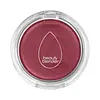What's inside
What's inside
 Key Ingredients
Key Ingredients

 Benefits
Benefits

 Concerns
Concerns

 Ingredients Side-by-side
Ingredients Side-by-side

CI 77891
Cosmetic ColorantDimethicone
EmollientHydrogenated Polyisobutene
EmollientMica
Cosmetic ColorantIsodecyl Neopentanoate
EmollientHydrogenated Polydecene
EmollientPhenyl Trimethicone
Skin ConditioningPolyethylene
AbrasiveEthylhexyl Hydroxystearate
EmollientCI 77491
Cosmetic ColorantCI 77492
Cosmetic ColorantPolymethyl Methacrylate
Silica
AbrasivePolyglyceryl-3 Diisostearate
EmulsifyingBeeswax
Emulsion StabilisingMicrocrystalline Wax
Emulsion StabilisingTribehenin
EmollientAscorbyl Palmitate
AntioxidantBHT
AntioxidantEthylhexyl Palmitate
EmollientParfum
MaskingGlucomannan
Skin ConditioningPhenoxyethanol
PreservativeCI 15850
Cosmetic ColorantSodium Hyaluronate
HumectantTalc
AbrasiveTocopherol
AntioxidantTocopheryl Acetate
AntioxidantTrihydroxystearin
Skin ConditioningCI 77007
Cosmetic ColorantCI 77891, Dimethicone, Hydrogenated Polyisobutene, Mica, Isodecyl Neopentanoate, Hydrogenated Polydecene, Phenyl Trimethicone, Polyethylene, Ethylhexyl Hydroxystearate, CI 77491, CI 77492, Polymethyl Methacrylate, Silica, Polyglyceryl-3 Diisostearate, Beeswax, Microcrystalline Wax, Tribehenin, Ascorbyl Palmitate, BHT, Ethylhexyl Palmitate, Parfum, Glucomannan, Phenoxyethanol, CI 15850, Sodium Hyaluronate, Talc, Tocopherol, Tocopheryl Acetate, Trihydroxystearin, CI 77007
Dimethicone
EmollientIsononyl Isononanoate
EmollientCetearyl Isononanoate
EmollientTrimethylsiloxyphenyl Dimethicone
Mica
Cosmetic ColorantPolyethylene
AbrasiveLauryl Dimethicone
Skin ConditioningDicalcium Phosphate
AbrasiveSilica
AbrasiveNylon-12
Polymethyl Methacrylate
Dimethicone/Divinyldimethicone/Silsesquioxane Crosspolymer
HumectantPentaerythrityl Tetra-Di-T-Butyl Hydroxyhydrocinnamate
AntioxidantWater
Skin ConditioningAscorbyl Palmitate
AntioxidantTourmaline
Ricinus Communis Seed Oil
MaskingSodium Hyaluronate
HumectantHydrogenated Castor Oil
EmollientCalcium Aluminum Borosilicate
Tin Oxide
AbrasiveCI 42090
Cosmetic ColorantIron Oxides
CI 15850
Cosmetic ColorantCI 77891
Cosmetic ColorantCI 19140
Cosmetic ColorantDimethicone, Isononyl Isononanoate, Cetearyl Isononanoate, Trimethylsiloxyphenyl Dimethicone, Mica, Polyethylene, Lauryl Dimethicone, Dicalcium Phosphate, Silica, Nylon-12, Polymethyl Methacrylate, Dimethicone/Divinyldimethicone/Silsesquioxane Crosspolymer, Pentaerythrityl Tetra-Di-T-Butyl Hydroxyhydrocinnamate, Water, Ascorbyl Palmitate, Tourmaline, Ricinus Communis Seed Oil, Sodium Hyaluronate, Hydrogenated Castor Oil, Calcium Aluminum Borosilicate, Tin Oxide, CI 42090, Iron Oxides, CI 15850, CI 77891, CI 19140
Ingredients Explained
These ingredients are found in both products.
Ingredients higher up in an ingredient list are typically present in a larger amount.
Ascorbyl Palmitate is created by combining pure Vitamin C and palmitic acid. It is an antioxidant and helps reduce hyperpigmentation.
This ingredient is a more stable version of Vitamin C, meaning it does not disintegrate as quickly when exposed to sunlight. However, studies show it does not penetrate skin as well as pure Vitamin C.
Ascorbyl Palmitate is oil soluble.
Read more about other types of Vitamin C:
Learn more about Ascorbyl PalmitateCi 15850 is the pigment color red. It is an azo dye and created synthetically.
Azo dyes need to be thoroughly purified before use. This allows them to be more stable and longer-lasting.
This ingredient is common in foundations, lipsticks, and blushes. This color is described as brown/orangey red.
It has many secondary names such as Red 6 and Red 7. According to a manufacturer, Red 6 usually contains aluminum.
Learn more about CI 15850Ci 77891 is a white pigment from Titanium dioxide. It is naturally found in minerals such as rutile and ilmenite.
It's main function is to add a white color to cosmetics. It can also be mixed with other colors to create different shades.
Ci 77891 is commonly found in sunscreens due to its ability to block UV rays.
Learn more about CI 77891Dimethicone is a type of synthetic silicone created from natural materials such as quartz.
What it does:
Dimethicone comes in different viscosities:
Depending on the viscosity, dimethicone has different properties.
Ingredients lists don't always show which type is used, so we recommend reaching out to the brand if you have questions about the viscosity.
This ingredient is unlikely to cause irritation because it does not get absorbed into skin. However, people with silicone allergies should be careful about using this ingredient.
Note: Dimethicone may contribute to pilling. This is because it is not oil or water soluble, so pilling may occur when layered with products. When mixed with heavy oils in a formula, the outcome is also quite greasy.
Learn more about DimethiconeMica is a naturally occurring mineral used to add shimmer and color in cosmetics. It can also help improve the texture of a product or give it an opaque, white/silver color.
Serecite is the name for very fine but ragged grains of mica.
This ingredient is often coated with metal oxides like titanium dioxide. Trace amounts of heavy metals may be found in mica, but these metals are not harmful in our personal products.
Mica has been used since prehistoric times throughout the world. Ancient Egyptian, Indian, Greek, Roman, Aztec, and Chinese civilizations have used mica.
Learn more about MicaPolyethylene is a synthetic ingredient that helps the skin retain moisture. It is a polymer.
It is also typically used within product formulations to help bind solid ingredients together and thicken oil-based ingredients. When added to balms and emulsions, it helps increase the melting point temperature.
This ingredient is also known as PMMA. It is a polymer microsphere, composed of tiny, perfectly spherical particles formed from repeating units.
In cosmetics, PMMA is mainly used to give a soft or blurring effect. The transparent particles are able to scatter light and help reduce the appearance of fine-lines and imperfections.
PMMA is also able to enhance the texture of products by add a smooth feel.
Learn more about Polymethyl MethacrylateSilica, also known as silicon dioxide, is a naturally occurring mineral. It is used as a fine, spherical, and porous powder in cosmetics.
Though it has exfoliant properties, the function of silica varies depending on the product.
The unique structure of silica enhances the spreadability and adds smoothness, making it a great texture enhancer.
It is also used as an active carrier, emulsifier, and mattifier due to its ability to absorb excess oil.
In some products, tiny microneedles called spicules are made from silica or hydrolyzed sponge. When you rub them in, they lightly polish away dead skin layers and enhance the penetration of active ingredients.
Learn more about SilicaSodium Hyaluronate is hyaluronic acid's salt form. It is commonly derived from the sodium salt of hyaluronic acid.
Like hyaluronic acid, it is great at holding water and acts as a humectant. This makes it a great skin hydrating ingredient.
Sodium Hyaluronate is naturally occurring in our bodies and is mostly found in eye fluid and joints.
These are some other common types of Hyaluronic Acid:
Learn more about Sodium Hyaluronate